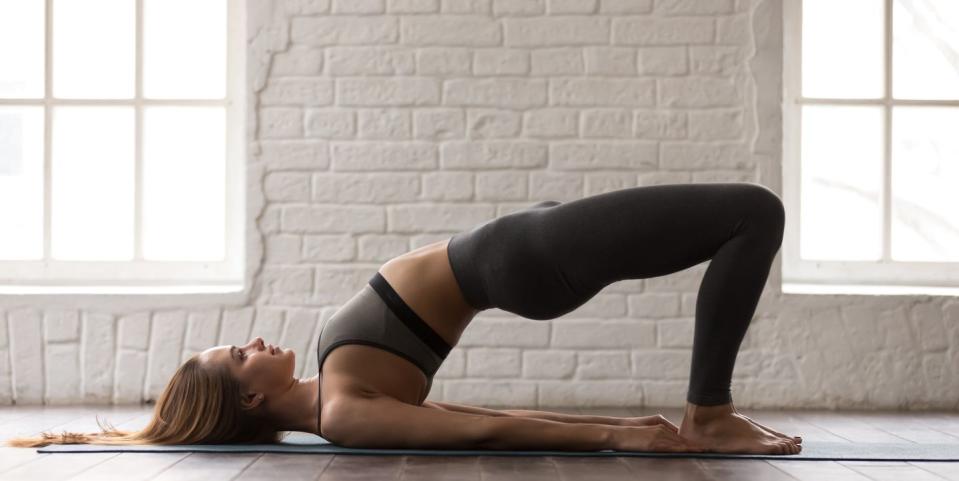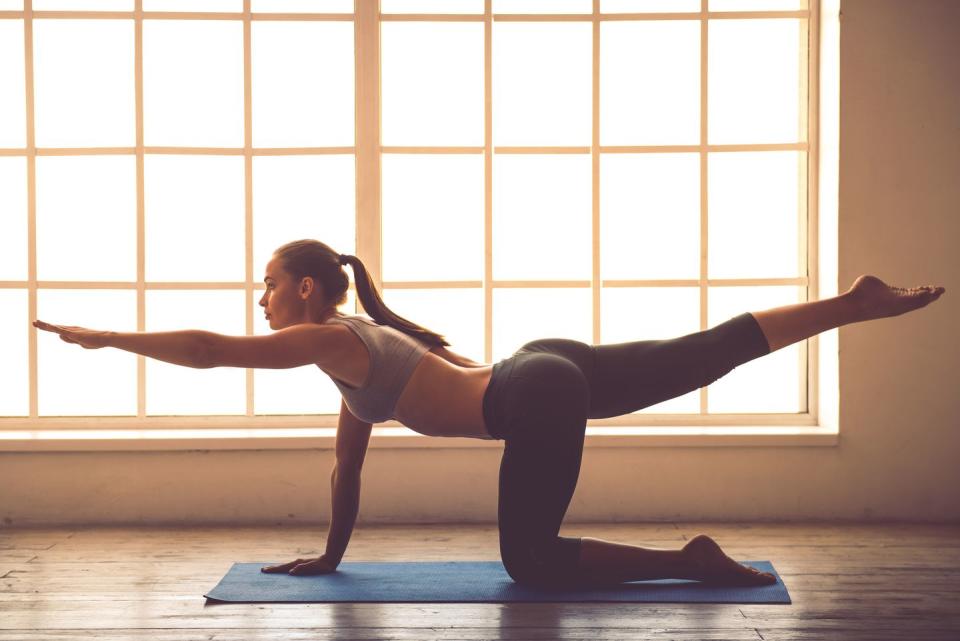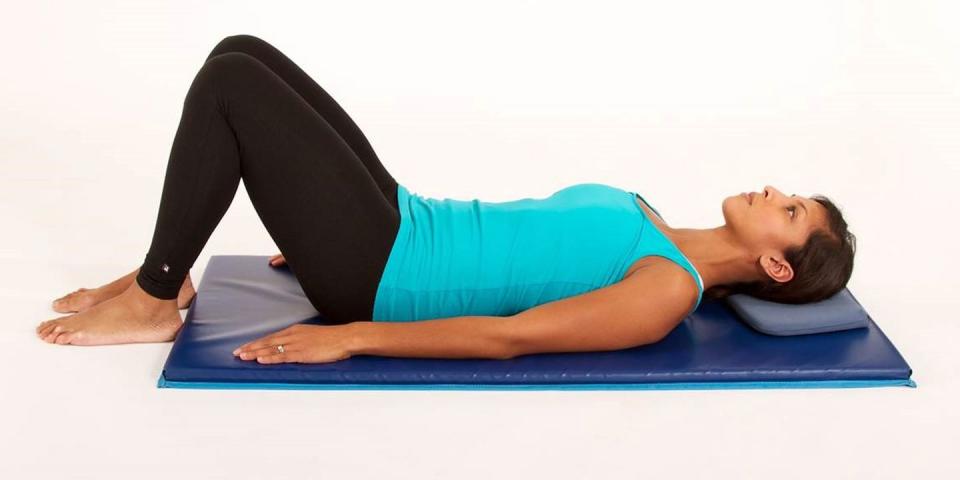Back pain? Try these 3 Pilates moves for some relief

When back pain strikes, it can be brutal. In fact, one study found that lower back pain is more debilitating than any other condition.
It affects one in 10 people and it is on the rise, according to Dr Bhupal Chitnavis, Consultant neurosurgeon at London Bridge Hospital.
"It appears back pain is on the increase," Dr Chtinavis explains. "Partly through increases in the numbers of older people, partly from obesity, partly from our increasingly sedentary lives and potentially from doing the wrong exercises and being injured during sport."
How Pilates can help ease back pain
If you’re one of the unlucky people who struggles with a sore back, you might be starting to lose hope. But the good news is, there is plenty you can do to treat back pain without having to rely solely on medicines. Pilates can go a long way to treating and even preventing back pain.
Pilates promotes a strong and flexible spine
One of the main reasons people suffer from back pain is poor posture. Pilates can strengthen and train the small and large muscles attached to the spine. These muscles are important for coordinating movements.
"The goal of Pilates is to make the spine both stable and mobile," says Lynne Robinson, Pilates Guru and co-founder of Body Control Pilates. "We teach clients how to move their spine sequentially with control. This entails re-educating movement patterns and working on the deep back and abdominal muscles which support the spine."
Robinson also maintains that Pilates is the ideal exercise for anyone concerned with the health of their back, because it puts you back in control of your body. "A strong and flexible spine is high on our list of priorities. Joseph Pilates said that If your spine is inflexibly stiff at 30, you are old, if it is completely flexible at 60, you are young."
Pilates can improve your posture
If you don’t work to keep your body in it’s correct alignment, you can end up with back and neck problems later on.
A good posture allows the optimum distribution of force through the body so the musculoskeletal system can function properly and protect against injury and deterioration. If the spine is not held straight, the internal organs are crowded, which can reduce their effectiveness.
Pilates can strengthen the body’s own muscular ‘corset’ that supports and protects the body during everyday movements. This corset of muscles around the torso often becomes weak after years of poor posture.

Pilates for back pain
If you are going to try Pilates for back pain, Robinson recommends the following:
Find a Back4Good Healthy Backs class and attend regularly
Take your time to do the exercises properly and practice at home too
Take what you learn in class into your daily life and sit, stand and walk tall
Don’t slouch
Lift carefully. If you have to lift a heavy object stand square to it and bend from your hips and knees, keeping your back straight
Lying down to relieve back pain is not a good solution other than in the very short term. Most doctors now advise anyone with nonspecific chronic low back pain to stay active. "Keep moving. Don’t be tempted to stay in bed, it is movement that will get your back strong again," says Robinson.
Try these Pilates moves for back pain
Robinson recommends the following three exercises from the Back4Good programme to mobilise your back. If you are in acute pain, check with your doctor before trying any new exercise programme.
The Relaxation Position with the ABCs

In this starter exercise you learn the ABCs on how to position your body, breathe and activate your deep core muscles. A few minutes relaxing in this position can also help release tension in your back.
Starting position
Lie on a mat on your back with your knees bent, feet hip-width apart and parallel. Check that your pelvis is level (neutral) and your spine retains its natural curves. Place a flat folded towel beneath your head if it is more comfortable. Take a few breaths, wide and full into the back and sides of your rib cage.
Action
Breathe wide into the rib cage.
Breathe out, and gently squeeze your back passage as if trying to prevent passing wind and bring this feeling forward to your pubic bone. Then gently draw these muscles up inside like an internal zip. Notice what happens to your lower abdominals? If you wish you can check placing your fingers just inside your pelvic bones. You should be able to feel them engage, gently hollowing away from your fingers.
Breathe in and hold this ‘core’ zip.
Breathe out and release.
Now try again but this time try adding several breaths as you hold the gentle internal zip. Breathe wide and full into the back and sides of your rib cage, before releasing.
If you found it hard to breathe, you have zipped up too far. Whenever you do Pilates, you can use this zip, if you need to, in order to control your movements. You should find that by controlling your breathing and alignment, your zip works automatically.
Starfish
This mobilises the hip and knee whilst challenging the stability of the pelvis and the spine. It teaches disassociation of the thigh at the hip. Similarly it mobilises the shoulder girdle and teaches disassociation of the arm at the shoulder joint. Sounds complex for a simple pattern of movement, but is remarkable effective.
Starting position
The Relaxation Position above, your arms lengthened down by your sides.
Use your core (zip) appropriately to control your alignment and movement.
Action
Breathe wide and full into the ribs to prepare.
Breathe out as you raise one arm back as far as you can without disturbing the upper spine or rib cage ( note you may not be able to touch the floor). Simultaneously, slide the opposite leg away in line with your hip, without disturbing the pelvis.
Breathe in to hold the position.
Breathe out to return the arm and leg. Repeat 5 times to each side.
Watchpoints
Think wide and open across your collarbones.
Maintain a distance between ears and shoulders.
Visualise using the back of the thigh to help draw the leg back to the Starting position.
Try to return to the exact Starting position.
The Cat
This exercise teaches you how to mobilise the spine, segment by segment. Take your time to move bone by bone.
Starting position
Go onto all fours with your hands beneath your shoulders and your knees directly beneath your hips. Your spine should be lengthened with its natural curves.
Use your core (zip) appropriately to control your alignment and movement.
Action
Breathe in wide to prepare.
Breathe out as you roll your pelvis underneath you as if directing your tailbone between your legs. As you do so, your lower back will gently round, continue this movement allowing your upper back to also round, followed by your neck, and finally nod your head slightly forwards.
Breathe in wide to the lower rib cage.
Breathe out as you simultaneously start to unravel the spine, sending the tailbone away from you, bringing the pelvis back to level (neutral). Lengthen the head and upper spine back to the starting position.
Repeat up to ten times.
Watchpoint
For Actions 1-3 do not overly round the upper back and ignore the lower back.
Focus on moving sequentially vertebra by vertebra.
If your pain hasn’t improved after six weeks, visit your GP. If they feel it is appropriate, your doctor may also refer you to a Back4Good practitioner.
In need of some at-home inspiration? Sign up to our free weekly newsletter for skincare and self-care, the latest cultural hits to read and download, and the little luxuries that make staying in so much more satisfying.
Plus, sign up here to get Harper’s Bazaar magazine delivered straight to your door.
You Might Also Like

